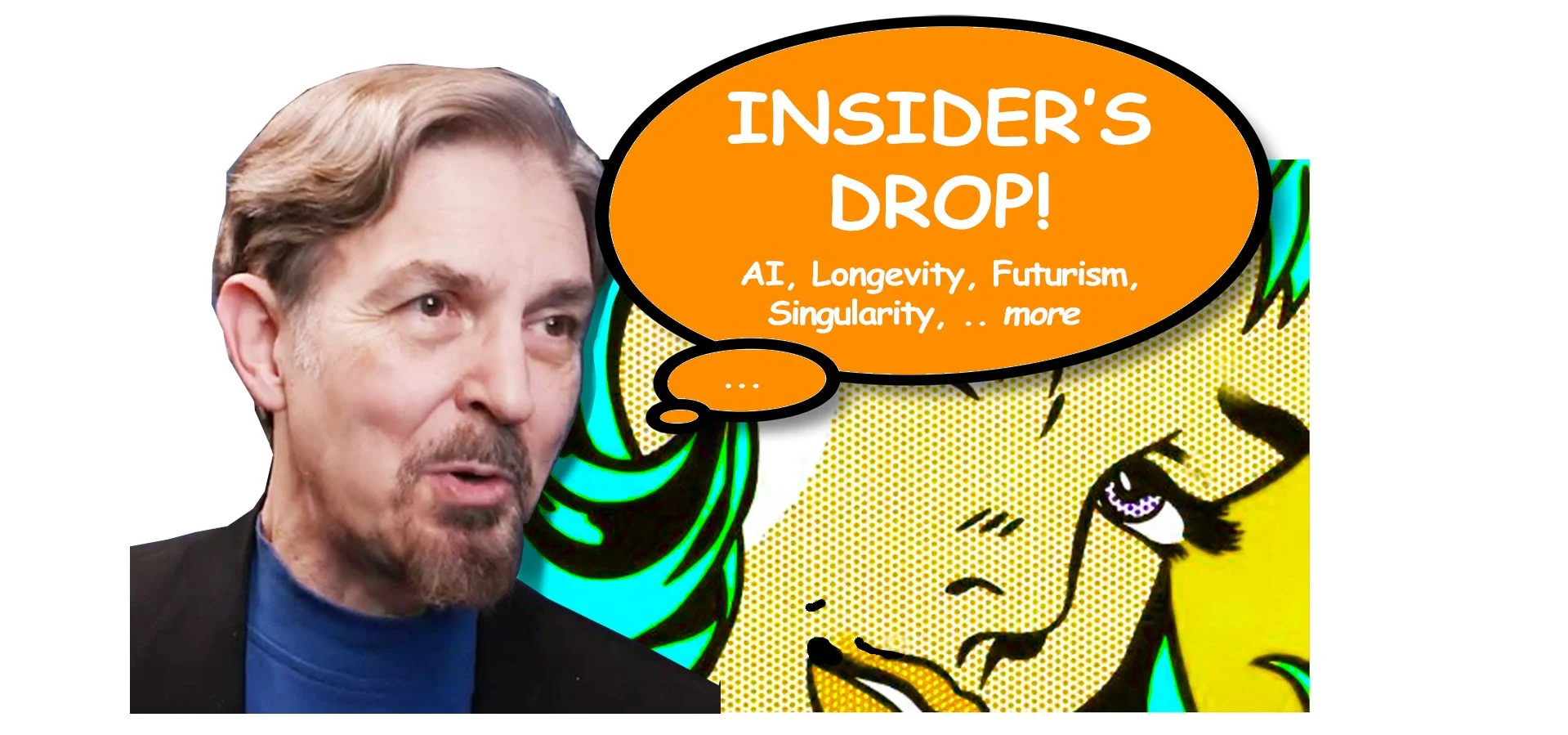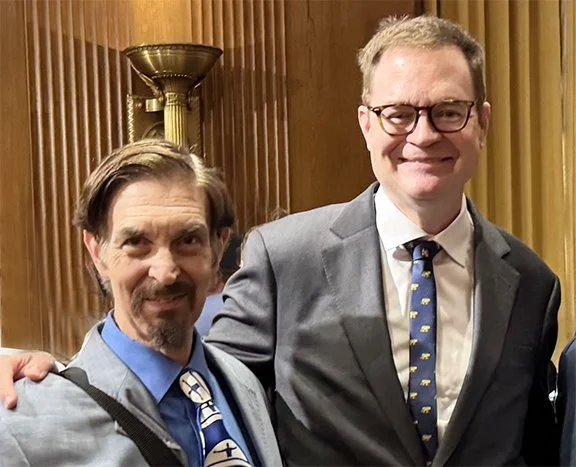INSIDER'S DROP —
INSIDER'S DROP —
Edward Hudgens shares first-hand experiences and newsworthy insights highlighting the real-world challenges and paths forward toward our best future, with a focus on Policies on AI/AGI, longevity, including governance worldwide; Exponential Technology Policies; Futurizing Education, and Cultural trends and attitudes impacting humanity’s tech future.
November 2025
Moms for Artificial Intelligence?
By Edward Hudgins, Ph.D., Humanity+ Board Member & Founder of the Human Achievement Alliance
It’s crucial to explain the benefits of artificial intelligence to the wider society across ideological and party lines. It’s not Right wing or Left wing but Up wing! That’s what I tried to do recently at the Moms For Liberty annual summit, attended by some thousand women and associated guys in Orlando, Florida.
Troubles with schools and tech.
Conservative women in this group are concerned about our schools’ failures to educate our kids in the basics and in critical thinking. They also fear that schooling too often focuses on indoctrination rather than education, undermining moral character, personal responsibility, and our civilization’s principles.
Many moms I talked to at the conference understood the promise of technology; indeed, many took part in a workshop on using AI in advocacy.
But many also voiced serious concerns about AIs and associated tech. AIs can create deep fakes. Excess smart phone screen time contributes to the mental health crisis among young people. Chatbots allow for cheating on school assignments. Chat-GPT and other Als can offer users information that they think the user wants to hear rather than all the facts. Several teens have committed suicide at the urging of chatbots.
Converging on AI.
Yet I see several factors that converge on a central role for AI in education.
To begin with, the current schooling system is a century-old, one-size-fits-all, assembly line model that was meant to offer minimal training for industrial workers. But it is certainly out of date for the needs of a future when brains and entrepreneurial mindsets are what will create the most value, to say nothing of personal flourishing.
Further, more states are expanding the liberty of parents to use tax credits, vouchers, and education savings accounts to allocate the funds earmarked for their children’s schooling to alternative educational institutions, a policy strongly supported by Moms. In Florida, for example, some 50 percent of kids access charter schools, private schools, or home schooling rather than specific government schools mandated by their zip codes.
So how do failing schools and parental choice point to AI?
Four factors favoring AI in education.
In the debate at the Moms summit, I took the affirmative for AI in classrooms, offering four reasons for how it can “future-proof” our kids.
First, kids need to understand AI because it is here and radically transforming the economy, social institutions, public policy, and culture. They need to understand how AI works, the trajectory of its evolution, and its implications for all aspects of our society. And they will need to understand it so they can develop ways to overcome the downsides that are concerns to Moms and many others.
Second, kids will need to use AI in their careers and in every aspect of their lives. They can be curing diseases, extending healthspan and longevity, creating new efficient products, services and whole sectors, terraforming Mars, and unleashing an unimaginably bright and prosperous future. Such purpose-driven lives require the moral character and personal responsibility favored by Moms.
Third, kids need to understand the synergy between AIs with their associated tech and the individual liberty so favored by Moms. Liberty has been essential for innovators creating these technologies and these technologies expand our own opportunities to follow our own dreams and enjoy our own lives.
Fourth, AIs will be essential for replacing the current assembly line schooling system with individualized education. There’s a reason why the Google co-founders, why Amazon’s Jeff Bezos and why so many other tech entrepreneurs went through the individualized approach in Montessori schools. With expanding school choice, parents will seek out such tailored education, and to scale up to meet the demand, alternative schools and perhaps even government schools will need to employ AIs that can help students learn at their own individual paces, using interactive discussions, and leveraging the unique ways individual kids learn—some more visual, some more text-oriented, some more hands-on. In fact, the Kahn Academy, innovators in online learning, does just this with their Kahnmigo AI teaching assistant!
The feedback from my remarks were thoughtful, some moms still skeptical, many more positive, seeking additional information. And outreach to groups like Moms is crucial for creating the understanding necessary for a humanity plus future.
August 2025
A Win for Proactionary AI Policy
In a just-fought battle over the future of artificial intelligence, the Proactionary Principle racked up victory over the Precautionary Principle.
Here in the U.S., the administration releasing Winning the Race: America’s AI Action Plan and will work through executive action to implement it.
It offers a ringing optimistic vision that AI “will usher in a new golden age of human flourishing, economic competitiveness, and national security for the American people. AI will enable Americans to discover new materials, synthesize new chemicals, manufacture new drugs, and develop new methods to harness energy—an industrial revolution. It will enable radically new forms of education, media, and communication—an information revolution. And it will enable altogether new intellectual achievements: unraveling ancient scrolls once thought unreadable, making breakthroughs in scientific and mathematical theory, and creating new kinds of digital and physical art—a renaissance.”
The context of this Action Plan is that so far this year, over 1,000 mostly precautionary proposed regulations have been put forward mostly in state legislatures. Most are innovation-killing, for example, requiring annual safety inspections with vague and contradictory standards or guarding against alleged “algorithm discrimination,” whatever that means. California, New York, and Illinois are the three states most active in pushing European-style, innovation-killing restrictions. The latter, for example, has just banned the use of AI in therapy. AI companies could not adhere to a patchwork of 50 different sets of standards, so they would likely have to kowtow to the legal restrictions of the largest states, i.e., the three mentioned above.
There are, of course, serious challenges emerging from AI, for example, how to deal with deep fakes, intellectual property, and security. But a Proactionary approach means letting AI-creating and -adopting companies experiment with various approaches to these challenges, letting the competition play out. Look back 50 years: Apple offered a tightly-integrated hardware-software closed ecosystem, eventually adding new products and services. Microsoft offered operating systems to all computer hardware manufacturers. At various stages, Microsoft was winning in the market, at other stages it was Apple, and now both prosper and still compete, especially in AI. Policymakers need to allow the same dynamism in AI.
The administration’s plan will still come into legal conflict with innovation-killing state restrictions. And that plan is not perfect, but that’s okay because it’s open discussion, experimentation, and competition that will unleash our AI-enhancing future.
June 2025
US Department of Health & Human Services
This month, after several Senate confirmation hearings, Jim O’Neill has been sworn in as Number Two at the Department of Health and Human Services. This department oversees the Food and Drug Administration, Centers for Disease Control, Medicare, Medicaid, and much more.
“Jim O’Neill confirmation”
Jim’s ascent is an opportunity to mainstream an understanding that aging, with its many mental and physical afflictions, need not be our fate.
Jim also served at HHS from 2002 to 2008, so he knows the ins and outs of this government department of 62,000 employees. But most important, he served for years as CEO of the SENS Research Foundation. As most friends of Humanity Plus know, SENS was the premiere group developing, as its initials stand for, Strategies for Engineering Negligible Senescence. Jim understands that rather than simply developing treatments for cancers, heart disease, Alzheimer’s and other ravages of aging once they afflict us, it is best to attack aging itself.
But science and technology are not enough. We need to raise the consciousness of the public and policymakers so they understand that we each can have truly long, vibrant lives if we make slowing or stopping aging a top goal. Jim in his perch at HHS, with the help of the longevity community, to meet this challenge!
June 2025
LONGEVITY POLICIES
“Braining COVID Vaccines and Longevity”
As countries around the world begin to develop policies for longevity, it’s clear that we’re at a pivotal moment in healthcare. If we’re to move from “sickcare” to healthspan and longevity, we must rethink and rewire the thinking processes of both the public and policymakers.
First, longevity education efforts should be elevated above political and partisan differences as much as possible. This is a universal challenge that transcends borders and ideologies.
Second, open and honest discussions are essential, with no room for censorship or dogma. Global collaboration requires transparency and an exchange of ideas that welcomes all perspectives.
Third, we must help public and policymakers understand that the discoveries and technologies applied to longevity are experimental, evolving, and often uncertain. But rather than being deterred by uncertainty, this should inspire action. Proaction—trying, failing, learning, and trying again—will bring us closer to a future where the ailments that have always plagued humanity can be vanquished.
Let’s cultivate futurist minds and technologies, not just for our generation but for generations to come. The future of longevity is global, and it’s time to build it together.
READ MORE ON BLOG. Longer piece focusing on What is happening in Washington, DC with “Braining COVID Vaccines and Longevity” and the U.S. Health and Human Services Secretary insider’s view featured on the BLOG!



